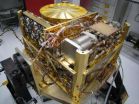(Press-News.org) RICHMOND, Va. (Oct. 8, 2010) – An international team of researchers has discovered a new class of highly electronegative chemical species called hyperhalogens, which use superhalogens as building blocks around a metal atom. The new chemical species may have application in many industries.
Researchers from Virginia Commonwealth University, McNeese State University in Lake Charles, La., and the University of Konstanz in Germany report their discovery in the Oct. 6 international chemistry journal Angewandte Chemie International Edition. The journal designated the paper as "very important," recognition granted to only 5 percent of papers it receives.
Chlorine is one of the elements called halogens, a group that includes fluorine, bromine, and iodine. These chemicals are known for their disinfecting and deodorizing power and are also used in some medications and industrial processes. Researchers say that hyperhalogens could be useful in industries where large amounts of halogens are now needed to make cleaning or decontamination products.
Chemists and physicists like Puru Jena, Ph.D., distinguished professor of physics at VCU, know halogens for their reactivity, a characteristic that makes the halogen elements want to bond with another element or a compound by taking one electron. Chlorine, for example, likes being paired with sodium to make table salt. Sodium wants to give away an electron and chlorine wants to take that electron in what Jena calls "a perfect marriage."
"Halogens only need one electron to reach their happy state," said Jena. "They're much more stable as a negative ion than as a neutral atom."
Once the atom takes an electron and becomes a stable, negative ion, the energy it gains is measured by its electron affinity. In chemistry's periodic table, chlorine has the highest electron affinity, measured at 3.6 electron volts, or eV.
One area of Jena's research focuses on finding ways to make new classes of compounds with large electron affinities.
In 1962, English chemist Neil Bartlett found that platinum hexafluoride reacts with xenon to make a noble gas compound. Scientists were surprised because xenon was one of the stable or "noble" gases that rarely react with other elements. A dozen years later, two Soviet scientists, Gennady Gutsev and Alexander Boldyrev, showed that a larger class of molecules with a metal atom at the center surrounded by halogen atoms, similar to platinum hexafluoride, possesses electron affinities larger than that of chlorine. They termed these molecules "superhalogens."
"For example, you could take a sodium atom and a chlorine atom to make a sodium chloride molecule and then attach a second chlorine atom. That compound would then want another electron because of the extra chlorine," Jena said. "All of a sudden, the electron affinity, which is the characteristic we're after, becomes almost a factor of two larger than that of the chlorine atom. It becomes a superhalogen."
Superhalogens have similar, improved properties as halogens, Jena said.
Jena, together with Anil Kandalam, Ph.D., assistant professor at McNeese State University, theorized that they could push the electron affinity of a cluster or a molecule even higher, by using superhalogens as building blocks, instead of halogens, around a metal atom. The theoretical model was tested through experimental studies led by Gerd F. Ganteför, Ph.D., at the University of Konstanz. They termed these species with unusually large electron affinities as "hyperhalogens."
"We used gold as the metal and surrounded it with two boron-dioxide superhalogens and got a hyperhalogen with an even greater electron affinity," Jena said.
The team's synergistic approach involving theory and experiment produced a gold-borate hyperhalogen with an electron affinity of 5.7 eV. The team now is testing a hyperhalogen constructed with four boron-dioxide superhalogens and have reached an electron affinity of 7 eV, with a goal of building a hyperhalogen with 10 eV. These new hyperhalogens may lead to additional discoveries of novel chemicals, Jena said.
###
The theoretical investigations for the project were conducted by Jena and graduate student Mary Willis at VCU, along with Kandalam. The experimental work was conducted by Ganteför and graduate student Matthias Götz at the University of Konstanz.
The work was supported in part by the federal Defense Threat Reduction Agency and the Department of Energy.
About VCU and the VCU Medical Center: Virginia Commonwealth University is a major, urban public research university with national and international rankings in sponsored research. Located on two downtown campuses in Richmond, VCU enrolls more than 32,000 students in 211 certificate and degree programs in the arts, sciences and humanities. Sixty-nine of the programs are unique in Virginia, many of them crossing the disciplines of VCU's 13 schools and one college. MCV Hospitals and the health sciences schools of Virginia Commonwealth University compose the VCU Medical Center, one of the nation's leading academic medical centers. For more, see www.vcu.edu.
END
At 11 a.m. EDT on Oct. 8, Otto strengthened into a hurricane, becoming the eighth hurricane of the Atlantic Ocean season. NASA's Aqua satellite and the NOAA GOES-13 satellite captured images of Otto as he intensified.
Otto had maximum sustained winds near 75 mph, and the National Hurricane Center in Miami, Fla. noted that some strengthening is possible before it weakens on Saturday, Oct. 9. Otto was located about 445 miles south of Bermuda near 25.9 North and 64.0 West. It was moving east-northeast near 17 mph, and had a minimum central pressure of 979 millibars.
On ...
The Sample Analysis at Mars (SAM) instrument suite has completed assembly at NASA's Goddard Space Flight Center in Greenbelt, Md., and is nearly ready for a December delivery to NASA's Jet Propulsion Laboratory (JPL), Pasadena, Calif., where it will be joined to the Curiosity rover. SAM and Curiosity are set to fly on the on the upcoming Mars Science Laboratory (MSL) rover mission scheduled for launch in the fall of 2011.
SAM will become an automated, mobile laboratory as it is carried across Mars by the rover when the mission arrives at the Red Planet in 2012. Together ...
DALLAS – Oct. 12, 2010 – Researchers at UT Southwestern Medical Center have created an experimental vaccine against beta-amyloid, the small protein that forms plaques in the brain and is believed to contribute to the development of Alzheimer's disease.
Compared with similar so-called DNA vaccines that the UT Southwestern researchers tested in an animal study, the new experimental vaccine stimulated more than 10 times as many antibodies that bind to and eliminate beta-amyloid. The results appeared in the journal Vaccine.
Future studies will focus on determining the ...
Researchers at the University of Illinois at Chicago College of Medicine have found how gene expression that may contribute to drug resistance is ramped up in unusual types of breast tumors. Their findings may offer new therapy targets.
The study is published in the Oct. 8 issue of the Journal of Biological Chemistry, where it is designated a paper of the week.
Approximately 70 percent of breast cancers express the estrogen receptor. These "ER-positive" tumors usually respond to hormone-related therapies, such as tamoxifen or aromatase inhibitors. But not always.
"We ...
WASHINGTON, Oct. 9, 2010 — Help may be on the way for millions of people on the East Coast bugged out about the invasion of stink bugs. Scientists have reported a key advance in efforts to develop the first commercial repellent for stinkbugs, which are emerging as a major nuisance to homeowners and a devastating pest to some farm crops. They identified a natural substance in a fungus that infects a common weed and found that it shows potential as the first stinkbug repellent. Their study appeared in ACS' bi-weekly Journal of Agricultural and Food Chemistry.
Hiromitsu ...
CHICAGO -- Lifestyle interventions, including physical activity and structured weight loss programs, can result in significant weight loss for overweight, obese and severely obese adults, according to two reports that were posted online today by JAMA. The studies and accompanying editorials were made available early online to coincide with the presentation of these papers at the 28th Annual Scientific Meeting of the Obesity Society. The articles will appear in the October 27 print issue of JAMA.
According to background information in the papers, obesity is among the ...
In another article being released early online, Cheryl L. Rock, Ph.D., R.D., from Moores UCSD Cancer Center, La Jolla, Calif., and colleagues, conducted a randomized controlled trial of weight loss and weight maintenance in 442 overweight or obese women (BMI, 25 – 40), ages 18 to 69, over a two year period with follow-up between November 2007 and April 2010.
The women were randomized into three intervention groups: in-person, center-based (167 women) or telephone based (164 women) weekly one-to-one weight loss counseling, including free-of-charge prepackaged prepared ...
A subset of lung cancer patients seem to live longer and experience delays in disease progression when a new drug that targets a cancer-associated molecule called MET is added to treatment with erlotinib, the results of a double-blind Phase-II trial show.
Dr David Spigel, Director of lung cancer research for the Sarah Cannon Research Institute in Nashville, Tennessee reported the trial findings at the 35th Congress of the European Society for Medical Oncology (ESMO) in Milan, Italy.
The study included 128 patients with advanced non-small cell lung cancer who were ...
A surgical technique appears to offer quick and effective relief for debilitating spinal fractures often suffered by patients with metastatic cancer, researchers reported at the 35th Congress of the European Society for Medical Oncology (ESMO) in Milan.
Many patients with multiple myeloma, or those whose cancer has spread beyond the initial tumor site, suffer compression fractures in their spine. This is partly because the spine is one of the most common sites for metastatic spread of the disease, making the vertebrae brittle and at risk for fractures. Widely-used cancer ...
For patients with advanced lung cancer whose tumors carry EGFR activating mutations, first-line treatment with erlotinib nearly tripled progression-free survival compared to a standard chemotherapy combination, show results from the first prospective Phase-III study to report findings in this setting.
The new results from the OPTIMAL trial were reported at the 35th Congress of the European Society for Medical Oncology (ESMO) in Milan, Italy.
"Erlotinib is very effective and well tolerated in advanced NSCLC patients who harbor EGFR activating mutations. It is 2 to 3 ...

